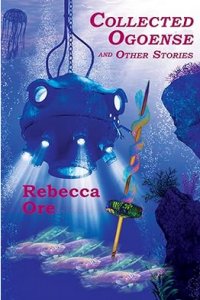Paul Di Filippo Reviews Collected Ogoense and Other Stories by Rebecca Ore
 Collected Ogoense and Other Stories, Rebecca Ore (Aqueduct Press 978-1619762480, trade paperback, 222pp, $20.95) November 2023
Collected Ogoense and Other Stories, Rebecca Ore (Aqueduct Press 978-1619762480, trade paperback, 222pp, $20.95) November 2023
Aqueduct Press reaches its twentieth anniversary in 2024. Helmed for all these years by the talented and dedicated L. Timmel Duchamp, the firm has—under the rubric of “Bringing challenging feminist science fiction to the demanding reader”—offered a wide range of stellar fiction and nonfiction that any of the Big Five would have been proud to publish—had the Big Five editors not been blinkered by commercial lusts. A case in point is the current volume. It’s an exciting, important collection, drafting up stories from the zines that deserve wider recognition and established permanence on the shelves. But its author labels herself “retired.” She has not had a new novel out since 2012. Her last new short story showed up in 2007. (All stats from ISFDB.) She is not riding any hot trend or Hollywood adaptation of her work. In short, the bean counters at the major firms would have found no reason to invest in such a writer.
And yet these stories—which do not overlap with Ore’s one previous collection, Alien Bootlegger—are valuable and enjoyable milestones in both Ore’s own career and the field at large. They represent the best of ‘90s SF, and manifest long-term merits as well. Posterity should be pleased to receive this book.
We open with a time-travel tale, “Hypocaust & Bathysphere”, which seems at first to be moving forward in the naturalistic Connie Willis manner seen in Blackout and All Clear, but which evolves into metaphysical absurdism tinged with savagery. Our point of view, for a change, is that of the natives, inhabitants of the medieval Danelaw territory of the British Isles. Oddly enough, these local royalty and peasants seem quite conversant with time-travelers. (A whiff of the hybrid culture in Poul Anderson’s The High Crusade hovers over the tale here.) It turns out that no matter where in the future the chrononauts start from, nor where they intend to go, they all end up at this nexus, for some strange cosmic reason. The latest pair, Morty and Sara, instantly find themselves caught up in the meshes of local politics and desires. The farce that ensues pits eras and cultures against each other, to the discredit of the high-tech folks. Ore’s trademark black humor is on display here, as it is in almost all the other pieces.
There is a region of the USA named Bracken County (adjacent to Manly Wade Wellman territory, no doubt), where magic rules—so we learn in “Stone Whorl, Flint Knife”. Here, a woman named Jaella mourns for her son, victim of an “accidental” shooting. Her hatred for the shooter summons up a single-mindedly helpful deity who wants to reify Jaella’s desires for revenge. But the new reality of enacting her payback causes her to reconsider her path—too late, or not?
We remain in Bracken County in “Horse Tracks”. A single mother named Sarah—wounded by a past encounter with a randy demigod—must contend with her adolescent daughter Emily’s desire for a magical horse. Despite all her protectiveness, Sarah finds that guarding her daughter from supernatural forces is nigh-impossible. Ore always gives gravitas to the fanciful parts of her tales with quotidian details. Taking her Bracken County car to her mechanic, Sarah realizes that “magic was rough on cars.”
“Half in Love with Easeful Rock and Roll” is the tale of a writer named Maude. Perplexed by her own mutable sexuality, trying to raise a fourteen-year-old son, she finds refuge in a virtual reality sim starring Janis Joplin. Her ex-girlfriend Em serves as role model, foil, challenge and irritant. The story is a slice of life, marked by no world-changing stakes or heavy-duty action sequences, just the poignant choices of two roads diverging in a wood.
In “Water Hammer”, a woman named Irene lives in a beach house with the dogs she breeds as her vocation. Her closest neighbor, Sandy, is an amateur painter. A local guy named Dubois is a mix of charm and menace, and Irene worries that he will do wrong by Sandy. But more of a threat is the local ghost dubbed The Gray Man. His manifestation during a storm will sweep up all the participants. I should mention at this juncture that Ore favors what is not precisely a stream of consciousness approach to her protagonists, but a definite abundant access to their interiority. You inhabit her characters as a rider in their minds.
“Accelerated Grimace” concerns an artist named Ralph and his wife/muse Marilyn. The tale is part of that grand SF subgenre: how will technology change art? Think of Walter Miller’s “The Darfsteller” as the primo example. Ralph wants to use the raw stuff of Marilyn’s thoughts (suctioned out by a device) as the tropes of his art. But what status does that confer on her? As Ralph’s ambitions progress to more outlandish modes of high-tech art (“On the end of a Sargassum fish’s first dorsal ray…I dangled naked, luring floating panels of Raphael madonnas into the gaping fish maw.”), Marilyn’s thoughts turn homicidal. The topicality of this tale benefits from the current discussions of AI-assisted art.
In “Scarey Rose in Deep History”, a handy timeviewer allows some folks to track down their ancestors and unriddle genealogical mysteries.
My absolute favorite tale herein is “Liquid Assets”, which reminds me of the last couple of novels by James Cambias: postmodern space opera with surreal bits. We start with a killer opening line: “Koch knew Trifalack was either rich or a fra user because she had her inner eye partially open.” From here we plunge into something of a heist tale, involving human art smuggler Koch and his alien client Trifalack (along with her servants who represent other intriguing alien species). The action is non-stop and the developments and outcome unpredictable. It’s almost a cyberpunk triumph.
Finally we reach the title story. A grimly resonant tale that might have flowed from the pen of James Tiptree or M. John Harrison, this one involves smuggled fish, an obsessive woman scientist named Sarafina, and the possible winnowing by disease of the human species. Its scientific details and speculative elements are top-notch. It oddly foreshadows Ned Beauman’s Venomous Lumpsucker (review here), last year’s winner of the Clarke Award.
Rebecca Ore blazed a distinctive path through the fantastika forests of the 1990s. Her unique voice consorts easily with that of Kit Reed or Margaret Atwood. Had she been more prolific, we’d be alluding to her work more often when speaking of the newer writers who are working—perhaps knowingly, perhaps unknowingly—in the same veins as she did. As matters stand, this collection will help preserve her undeniable and pleasurable accomplishments.
 While you are here, please take a moment to support Locus with a one-time or recurring donation. We rely on reader donations to keep the magazine and site going, and would like to keep the site paywall free, but WE NEED YOUR FINANCIAL SUPPORT to continue quality coverage of the science fiction and fantasy field.
While you are here, please take a moment to support Locus with a one-time or recurring donation. We rely on reader donations to keep the magazine and site going, and would like to keep the site paywall free, but WE NEED YOUR FINANCIAL SUPPORT to continue quality coverage of the science fiction and fantasy field.
©Locus Magazine. Copyrighted material may not be republished without permission of LSFF.







